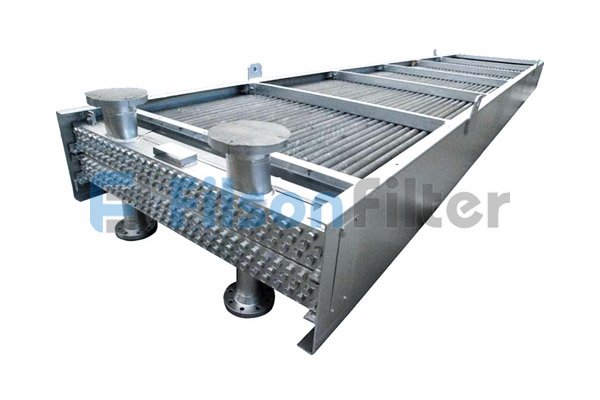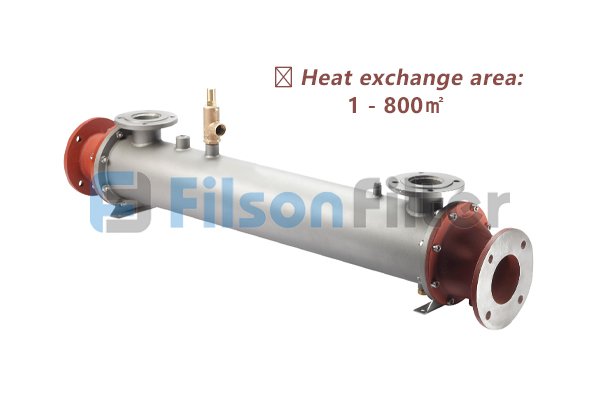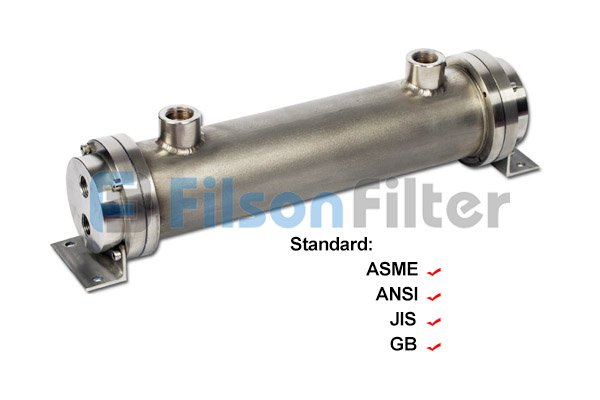Filson Gas Cooler Heat Exchanger
- High heat transfer efficiency
- Beneficial to energy savings
- Available to be customized according to requirements
- Easy maintenance and cleaning
- Specifications
- Send Us Inquiry
As its name implied, Filson gas cooler heat exchanger is used to cool down the temperature of gas. Usually, the gas is generated and produced during the industrial manufacturing and processing.
- Material: stainless steel, carbon steel, duplex stainless steel, cemaric, plastic and more
- Media type: oil, water, air, gas
- Working temperature: under 450℃(up on material and type)
- Working pressure: up to 9.93MPa
- Flow rate: 25L/min(depending on fluid type)
- Heat transfer efficiency: 75-85%
- Heat exchange area: 1 – 800㎡
- Color: grey, blue, silver, brown(based on customer requirements)
- Standard: ASME, ANSI, JIS, GB
Send Your Inquiry Today
Filson Gas Cooler Heat Exchanger
Custom Gas Cooler Heat Exchanger Based on Needs
The most frequently-used type of gas cooler is shell and tube heat exchanger. The exhaust hot gas discharged during the manufacturing processing is collected to the heat exchanger, and then is cooled down when passes through the heat exchanger.
With high heat transfer efficiency and low energy costs, Filson gas cooler heat exchanger has become an ideal device for heat recovery and exhaust gas cooling. By using it, both the environment and the workers’ health are guaranteed.
Customers can order specific size of a gas cooler heat exchanger from Filson. The size will vary according to your needs. Commonly, the length can be meters long, of course, it finally decided by customer specifications.
Talk to Filson today and get a suitable heat transfer solution for your application. Our specialists are waiting for you in 24/7.
Gas Cooler Heat Exchanger: The Ultimate FAQ Guide
In today’s guide, you’re going to learn everything you need to know about gas cooler heat exchanger.
Whether you want to learn about the components, size limitations, quality tests, material type or warranty period, every information you’re looking for is right here.
Keep reading to learn more.
- What is a Gas Cooler Heat Exchanger?
- What are the benefits of a Gas Cooler Heat Exchanger?
- How does a Gas Cooler Heat Exchanger Work?
- What are Gas Cooler Heat Exchangers used for?
- What are the features of a Gas Cooler Heat Exchanger?
- What is the range of applications for Gas Cooler Heat Exchangers?
- What are the Advantages of a Gas Cooler Heat Exchanger?
- Are there size limitations to Gas Cooler Heat Exchangers?
- What are the Materials used to Construct a Gas Cooler Heat Exchanger?
- What Design Codes and Compliance should the Gas Cooler Heat Exchangers adhere to?
- What are the Weaknesses of Gas Cooler Heat Exchangers?
- What are the Quality Tests for Gas Cooler Heat Exchangers?
- Are Gas Cooler Heat Exchangers customizable?
- Is it better to buy a Gas Cooler Heat Exchanger from a factory or an OEM business?
- How much does a Gas Cooler Heat Exchanger cost?
- What are the Components of a Gas Cooler Heat Exchanger?
- What is the Warranty for Gas Cooler Heat Exchangers?
- Is Heat Transfer/Efficiency Better in Corrugated Surface Tubes or Smooth Surface Tubes in Gas Cooler Heat Exchangers?
- What is the Maximum Pressure of Gas Cooler Heat Exchanger?
- Is Fouling a Serious Problem in Gas Cooler Heat Exchangers?
What is a Gas Cooler Heat Exchanger?
A gas cooler heat exchanger is a device that helps to regulate the gas temperature for further processing.
This enables you to meet the various process needs.
You can use this device in heat recovery and exhaust gas cooling applications.
It has a bundle of corrugated tubes mounted inside an outer tube that makes the outer shell.
The device has a smooth surface finish using matt material.
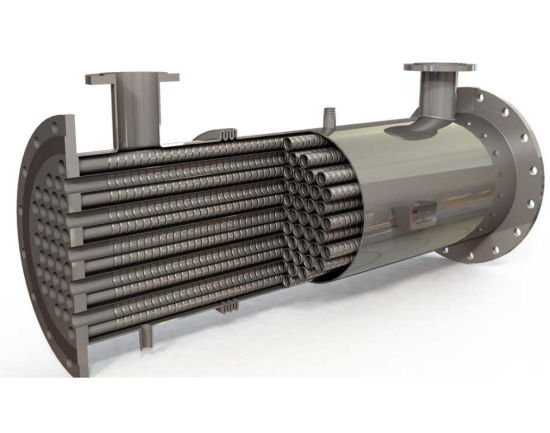
Gas cooler heat exchanger
What are the benefits of a Gas Cooler Heat Exchanger?
Gas cooler heat exchanger is better than the majority of the heat exchangers systems.
This is due to the several benefits it holds such as:
· Cost-effective maintenance
This device is durable and high quality.
It, therefore, does not require frequent maintenance of its parts.
A client will spend limited costs conducting the maintenance of the device.
· Easy Installation
Gas cooler heat exchangers are often manufactured in the factory and the parts assembled before delivery to clients.
When clients receive this device, the only thing that remains is installing it in the intended application.
It is very easy to install.
· Customization
You can customize gas cooler heat exchangers to reflect your application specifications.
One presents their drawings and designs to the manufacturer who produces the final gas cooler heat, exchanger.
· Low Fouling
Gas cooler heat exchangers have a low fouling, and this is because of the corrugated inner tube surfaces.
There is very limited sedimentation/deposit of residues inside the wall of the tubes.
· Low Loss of Pressure
The diameter of the pipes of the device as well as its overall size and structure of the tubes facilitate transfer of gases/fluids.
The device does not lose a lot of pressure.
· Cost-effective Operation
As the device have a high heat transfer efficiency, they are very cost-effective.
When in use, one does not have to pay for any repairs as they are limited.
· Flexibility
Gas cooler heat exchangers are developed in such a way that they can be applied in a wide range of applications.
They also come in different sizes such that they can fit different applications.
How does a Gas Cooler Heat Exchanger Work?
Typically, the gases flow through the interior tubes as the service fluids flow through the surrounding of the gas cooler heat exchanger’s shell.
As this happens, the fluid (gas) that is to be treated moves through the interior of the tubes forming the tube bundle.
In the process, the exchange of heat happens as the gases flow in different patterns within the device.
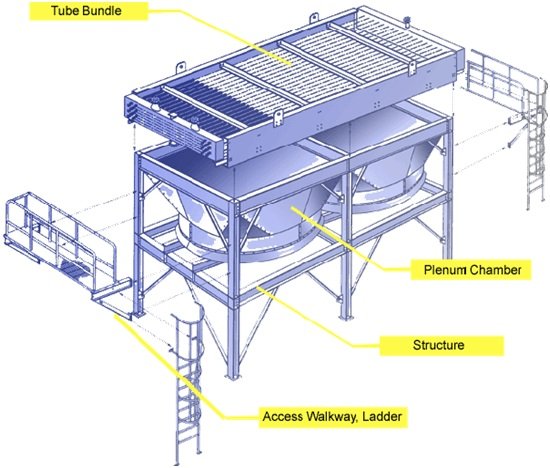
Air-cooled heat exchanger
The hot fluid that gets in through the inlet loses its heat to the fluid that leaves the device following the absorption.
This device often works based on the principles of conduction, convection, and condensation that facilitate efficient heat transfer.
The cooling that is needed in most of the exhaust heat recovery and cooling applications is achievable with this device.
What are Gas Cooler Heat Exchangers used for?
Gas cooler heat exchangers are used to control the temperatures of a flowing stream in various chemical processes.
This process involves increasing the heat efficiency of a cooling system by transferring between two gases flowing in the device.
What are the features of a Gas Cooler Heat Exchanger?
When a customer is purchasing a gas cooler heat exchanger there are specific features that they look for.
After all, you should ensure the heat exchanger is efficient and has excellent performance.
Some of the features of this device include:
- High heat transfer efficiency
- Simple structure improves its efficiency. The device can come in a vertical or horizontal structure depending on the available space in the plant.
- Compact design; inside the gas cooler heat exchanger are exchanger pipes and other key components.
- It has corrugated tubes for increased heat transfer and efficiency
- Easy installation as the device is fully assembled at the factory/plant
- Convenient cleaning as the different parts can be taken out for cleaning and returned. The device can also self-clean as it is built with this design.
- Strong adaptability
- High corrosion resistance as it is made using stainless material and have surface finish
- High operating pressures
- Multiple units can be interconnected for larger applications. Some of the ways of doing this are frame mounting, stainless less cladding and insulation.
What is the range of applications for Gas Cooler Heat Exchangers?
Gas cooler heat exchangers are designed and built in such a way that they are not only versatile but also flexible.
They can be used in a number of applications ranging from:
Heat recovery from:
- Boiler exhaust gas
- Cogeneration exhaust gas
- Flue gas/industrial exhaust gas
Others:
- Process engineering
- Dairy industry
- Energy industry (biomass and coal fired, oil-fired, gas-fired and power plant)
- Energy from waste plants
- Oil and gas industry
- Steam water heating
- Condensation
What are the Advantages of a Gas Cooler Heat Exchanger?
As compared to other heat exchangers, this device has a high heat transfer efficiency.
Its corrugated tube surfaces aid in this process.
While gas cooler heat exchangers have a high corrosion resistance, they are not as good as the titanium heat exchangers.
Even so, they still have excellent performance.
A client can use recovered heat to achieve the goals of the intended application.
As such, in various processes, a client does not have to use new fluids/gases to facilitate heat transfer.
Some Gas cooler heat exchangers have self-cleaning technology that aids in the easy cleaning of the device without having to bring the components out.
Gas cooler heat exchangers are sold at competitive prices.
Gas cooler heat exchangers cost around $300 and more depending on the size, intended application or source.
They are also cost-effective as they require limited repairs and maintenance.
This device is often high quality and durable hence serving a user for a long time.
Are there size limitations to Gas Cooler Heat Exchangers?
There are no size limitations to Gas cooler heat exchangers.
The sizes of the devices vary depending on the intended application, pipe diameters or source.
The lengths of the devices range from 1.5 to 3 meters.
Gas cooler heat exchangers can, however, be longer in length depending on what the customer needs.
You can even have up to 270 tubes in a single device. This feature increases the size of the gas cooler heat exchanger making it big.
The surface areas of the devices are equally large.
A gas cooler heat exchanger can have a surface area of 85.8 m2 to improve its efficiency.
What are the Materials used to Construct a Gas Cooler Heat Exchanger?
Gas cooler heat exchangers are made using materials with properties that improve the efficiency and performance of the device.
There are standard materials of construction for this device and optional materials.
The standard materials include:
- AISI 304 stainless steel (It is used for service side components). These are components not in contact with the working fluids.
It is also used for support frames.
- AISI 316L stainless steel (It is used to manufacture product wetted components such as the tubes, and bends)
Optional materials are:
- Aluminum
- Copper alloys
- Aluminum
- Titanium
These materials are used for the construction of the shell of the device and the other parts such as the tubes, tube bundle, tube sheets and safety valve.
Silicone rubber is for the O ring seals for the tube bundle units and connection gaskets.
The overall device has a sturdy construction and can withstand strong physical forces and fluid pressure when in operation.
What Design Codes and Compliance should the Gas Cooler Heat Exchangers adhere to?
Gas cooler heat exchangers are designed and used in different parts of the world.
For this device to be used in these parts, they have to undergo inspections that meet these nation’s quality standards.
Besides, during design, a manufacturer must adhere to codes set out by a standard body that guarantees the quality of the devices.
Some of the design codes and compliance standards are:
The design codes include:
- ASME Codes; with these codes customers understand that the pressure testing, chemical composition, strength and ratings of the gas cooler heat exchanger’s raw materials adhere to the industry’s quality mandates.
- PD 5500
- PED 2014/68/EU; this code requires a CE marking. This marking shows that the product can be used in the European Union as it is safe for use, good for the environment and conforms to the health standards.
Compliance:
- DOSH Compliance
- TR CU 032
What are the Weaknesses of Gas Cooler Heat Exchangers?
Even though the gas cooler heat exchangers have excellent performance and are high quality, they have some weaknesses such as:
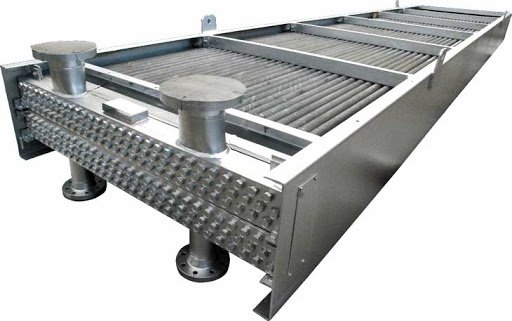
Air cooled heat exchanger
· Fouling
While fouling in this device is minimized, it can still happen.
The device is made using steel material that if continuously exposed to high-pressure and hot fluids can develop hot spots.
These hot spots result in mechanical failure of the tube surface.
· Maintenance
Maintenance costs of gas cooler heat exchangers can be high as the device experiences problems such as fouling and corrosion.
· Expensive Initial Cost
The initial price of this device is often high.
The price covers the costs of raw materials, manufacturing, and installation costs.
In some cases, it covers the shipping cost if the manufacturer does not pay for it.
Note: Gas cooler heat exchangers are excellent devices as their benefits outweigh their weaknesses.
What are the Quality Tests for Gas Cooler Heat Exchangers?
For a product is delivered to a customer, the manufacturer must ensure that it is safe to use.
Besides, it should be of high quality and compliant with the strictest industry quality standards.
These tests are done at different stages of the device ranging from the design, manufacture and after manufacture.
Some of these tests include:
i. Pressure Test
Pressure test is mainly done on the shell, tubes, and tube bundles.
You apply a pressure around 1.5 times that of design of the device for approximately 15 minutes.
When there is a burst during the pressure test, the device will experience leakages.
You can do this test well in a swimming pool.
ii. Radiography Test
A radiographic test is done, especially on the weld joints.
An X-ray of the weld joints shows whether the device has any cracks.
This test improves the efficiency of gas cooler heat exchangers.
You may need a non-destructive examination inspection to approve the radiographs before going ahead with product finalization.
iii. Sensitive Leak Test
This test is often done immediately after a radiography test.
It involves pressurizing the coil assembly using helium (if it has a coil assembly).
You then use an ultrasensitive helium detector to make sure there are no leaks in the coil assembly.
It is very easy for the analyzer to detect a helium leak equivalent to 1×10-9 cc per second.
If your product satisfactorily passes these tests a customer becomes sure of its quality and performance thus saving on costs.
iv. Hydrostatic Test
This test is done on the components of the device, most especially the tubes and tube bundles.
During design, you write down a value for the maximum pressure that can be applied to the device.
When doing the hydrostatic test, you apply the same pressure as this noted during the drawings.
You introduce the device to pressure, and the test is characterized as successful if it does not leak.
Tube leaks can be a serious problem if not identified early on during manufacture.
It is, therefore, important to conduct this test before releasing this product into the market.
You first open the device, remove the tube bundles and then test the gas cooler heat exchanger.
After this, you reassemble the parts to build the device.
v. Whole Unit Test
A whole unit test is done to evaluate the device as a whole.
The test is centered on the different parts of the device ranging from the shell, tubes, bundles, and weld joints.
Note: While the whole point of a gas cooler heat exchanger test is safety, it is imperative to keep in mind that cracks and porosity is serious problems.
It is important to conduct all of these tests on your device if you want to access a gas cooler heat exchanger with excellent performance.
Are Gas Cooler Heat Exchangers customizable?
Of course, yes.
All you have to do as a client is present your design specifications to the manufacturer/supplier to work on.
One presents their samples or drawings and the designer produces the final design for the Gas cooler heat exchanger.
Some of the design conditions are higher temperatures and pressures which are possible upon request.
There can be maximum and minimum allowable working pressures: 10 Bar/Full vacuum
The maximum and minimum allowable working temperatures 180°C and -40°C respectively.
All these aspects are factored/captured at the design stage of the has a cooler heat exchanger.
Is it better to buy a Gas Cooler Heat Exchanger from a factory or an OEM business?
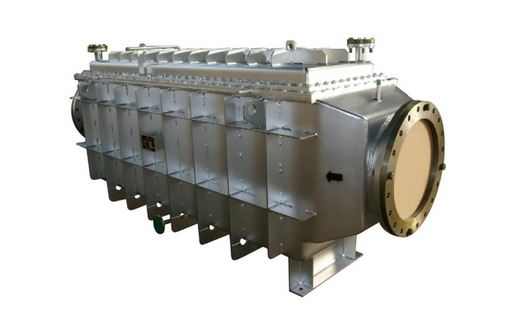
Gas cooler heat exchanger
Whether you buy a Gas cooler heat exchanger from an OEM business or factory depends on a number of factors.
Some of the factors include:
· Customization Services
Manufactures offer customization services to their clients allowing them to give their drawings/specifications to the designers.
As such, they access gas cooler heat exchangers that are unique to them or fit their applications.
Some OEM businesses may not offer customization services making it hard for clients seeking unique pieces of heat exchangers for their applications.
· Cost
The cost of a gas cooler heat exchanger includes not just the final price but also the installation, operating and maintenance costs.
OEM businesses usually access gas cooler heat exchanger parts from the manufacturing plants and assemble them to create the final device.
Their costs could be higher or lower depending on what they are charged.
Manufacturing plants fabricate the pieces and build the parts then assemble them to form the device.
The manufacture costs of the device could be high thus contributing the overall high price of the device.
· Availability of Gas Cooler Heat Exchangers
An OEM business may have limited numbers of gas cooler heat exchangers as they source the products from a supplier/manufacturing plant.
They obviously have the parts that they can assemble to build the devices but availability is not guaranteed.
In comparison, manufacturing plants have a constant supply of gas cooler heat exchangers, especially if they are a standard type.
Besides, clients access adequate amounts of customized devices.
· Warranty
Both OEM business and manufacturers offer warranty for their products.
There is a specified warranty upon receipt of gas cooler heat exchangers like 1 year or more.
· Samples
Manufacturers and OEM businesses both may offer samples of gas cooler heat exchangers to customers who ask for them.
A customer may want to see a sample before making a choice on what gas cooler heat exchanger to buy.
They can access samples of standard devices from these sources.
How much does a Gas Cooler Heat Exchanger cost?
Gas cooler heat exchangers are sold at competitive prices.
As such, any client can access this device for their intended application.
The price of the device can go up to $8,000 depending on the sizes.
Usually, the cost of the gas cooler heat exchanger includes cost of the raw materials, manufacturing, operation, installation and maintenance costs.
The price of a single customized ASME Gas cooler heat exchanger can go for around $1,000.
What are the Components of a Gas Cooler Heat Exchanger?
For the gas cooler heat exchanger to perform at its optimum best, it must have the following components:
· Shell Nozzles
They help ensure that the device is filled with water or other suitable fluids.
· Safety Valve Connection
This component helps in connecting the safety valve to the device thus protecting it from potential damages.
· Expansion Bellow
This component aids in thermal dilation. It
absorbs the differential expansion between the shell and the inner tubes.
· Shell Drain Point
This is an opening on the shell that helps in draining the fluids from the device.
· Tubes
Tubes are often attached to tube sheets to anchor them within the shell.
They are arranged in square and triangular patterns.
These patterns improve the device’s ability to transfer heat and facilitate turbulence.
· Tube Bundle
Tube bundles are the part of the device through which fluids go through.
What is the Warranty for Gas Cooler Heat Exchangers?
Gas heat exchangers have a warranty of 1 year or more depending on the manufacturer/supplier of the product.
With this warranty, a client can always return the device to the manufacturer/supplier for replacement or repair within the specified time.
It covers manufacturing defects only.
does not include physical damages caused by the client.
Is Heat Transfer/Efficiency Better in Corrugated Surface Tubes or Smooth Surface Tubes in Gas Cooler Heat Exchangers?
Heat efficiency/transfer is better over corrugated surface tubes than smooth surface tubes in Gas cooler heat exchangers.
The corrugation helps increase the turbulence of the fluid thus facilitating faster heat transfer in the device.
With a smooth surface, the fluids flow freely but may require more pressure to facilitate faster heat transfer.
That said, the corrugation technology is an important element in the efficiency of the device.
What is the Maximum Pressure of Gas Cooler Heat Exchanger?
The maximum pressure of a Gas cooler heat exchanger can go up to 1,440 PSI.
this value varies depending on the type of application used.
The value can be around 90PSI or more.
Is Fouling a Serious Problem in Gas Cooler Heat Exchangers?
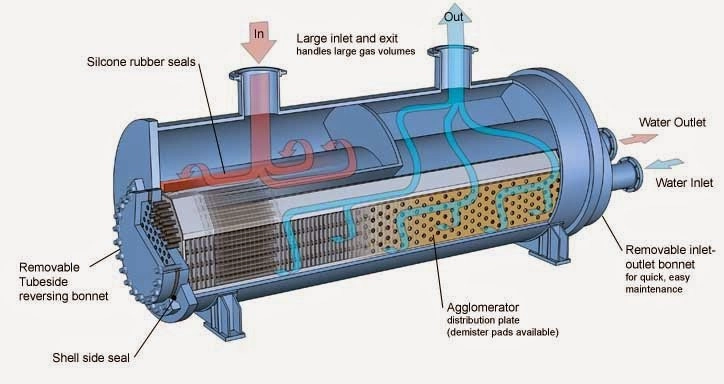
Air-cooled heat exchanger
Any potential fouling in gas cooler heat exchangers is minimized.
The corrugated surface of the device helps limit any vibrations or disturbance which could cause a delay in fluid flow leading to deposits.
Fouling is characterized by particulate matter settling as residues on the inside walls of the gas cooler heat exchanger’s tubes.
Since this device has a corrugated tube surface, there is very minimal fouling.
Depending on your specific needs, Filson Filters offers a range of heat exchanger systems, including plate heat exchangers and shell and tube heat exchangers.
Contact us today for all your gas cooler heat exchanger needs.
